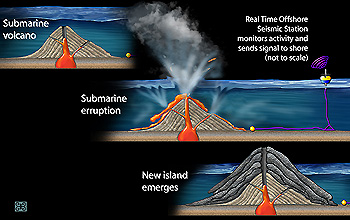News Release 07-109
Volcanic Activity Key to Oxygen-rich Atmosphere
Activity contributed to rise of complex biological forms
August 29, 2007
This material is available primarily for archival purposes. Telephone numbers or other contact information may be out of date; please see current contact information at media contacts.
Next time you catch a breath, be thankful, for a change, that the Earth's surface is dotted with volcanoes.
National Science Foundation-funded research published this week in the journal Nature indicates that billions of years ago, when the Earth was home largely to undersea volcanoes, some previously unknown agent was removing the gas.
The researchers suggest that mixture of gases and lavas produced by submarine volcanoes scrubbed oxygen from the atmosphere and bound it into oxygen-containing minerals.
Lee R. Kump, a professor of geosciences at Penn State University, working with a colleague at the University of Western Australia, looked at the geologic record from the Archaean--a geologic period from 3.8 to 2.5 billion years before the present day--and the Palaeoproterozoic-- geologic era immediately following that featured profound global change that included the breakup and formation of two supercontinents. They found that in the Archean there was a dearth of terrestrial volcanoes, while in the Palaeoproterozoic, although submarine volcanoes continued to be common, the population of terrestrial volcanoes increased dramatically.
"The rise of oxygen allowed for the evolution of complex oxygen-breathing life forms," Kump said.
Terrestrial volcanoes could become much more common because land masses stabilized and the current system of tectonics regime took shape.
Because submarine volcanoes erupt at lower temperatures than terrestrial volcanoes, they are more efficient at converting--or "reducing"--oxygen. As long as the reducing ability of the submarine volcanoes was larger than the amounts of oxygen created, the atmosphere had no oxygen. When terrestrial volcanoes began to dominate, oxygen levels increased.
The change over time caused an atmospheric shift from oxygen-free to oxygen-rich, the researchers argue, with profound implications for life on the planet.
-NSF-
Media Contacts
Peter West, NSF, (703) 292-7761, email: pwest@nsf.gov
A'ndrea Messer, Penn State University, (814) 865-9481, email: aem1@psu.edu
Principal Investigators
Lee R. Kump, Penn State University, (814) 863-1247, email: kump@essc.psu.edu
The U.S. National Science Foundation propels the nation forward by advancing fundamental research in all fields of science and engineering. NSF supports research and people by providing facilities, instruments and funding to support their ingenuity and sustain the U.S. as a global leader in research and innovation. With a fiscal year 2023 budget of $9.5 billion, NSF funds reach all 50 states through grants to nearly 2,000 colleges, universities and institutions. Each year, NSF receives more than 40,000 competitive proposals and makes about 11,000 new awards. Those awards include support for cooperative research with industry, Arctic and Antarctic research and operations, and U.S. participation in international scientific efforts.
Connect with us online
NSF website: nsf.gov
NSF News: nsf.gov/news
For News Media: nsf.gov/news/newsroom
Statistics: nsf.gov/statistics/
Awards database: nsf.gov/awardsearch/
Follow us on social
Twitter: twitter.com/NSF
Facebook: facebook.com/US.NSF
Instagram: instagram.com/nsfgov



